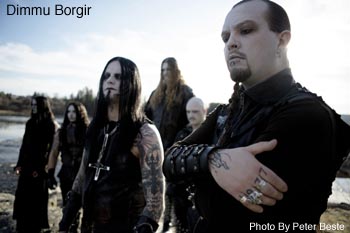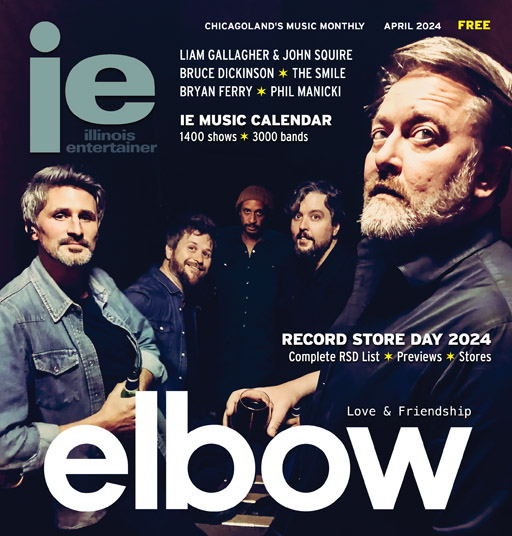Dimmu Borgir interview
Dimmu Borgir
Lords Of Commercial Chaos

For their first band photos in 1993, Dimmu Borgir wore foot-long spikes on their arms and posed with medieval swords and homemade clubs at night in the woods near Oslo, Norway. In the tradition of one-time Mayhem vocalist Dead, who committed suicide two years earlier, they smeared their faces with shock-white greasepaint, bubonic-black eyeliner, and inky, exaggerated frowns.
Appearing: Sunday, May 4th at House Of Blues in Chicago.
Dead had coined the term “corpsepaint” to describe this ghostly makeup, according to British newspaper The Observer. He painted himself not to evoke hard rockers Kiss or Japanese Kabuki performers, but to look, fittingly, dead, as if he were a plague victim from the 14th century.
For the vanguards of early Norwegian black metal, every day wasn’t Halloween, as it might appear from an ironic American perspective. Corpsepaint wasn’t merely a costume. It still isn’t, according to Dimmu Borgir guitarist/lyricist Silenoz, who wore a gothic splash of it during the band’s recent Internet-streamed concert in Columbus, Ohio.
“It’s a ritualistic feeling,” he says by phone at the onset of their current North American tour. “You jump into the character that you want to portray. It’s like an enhancement to your own self.” In limited, considerate English, he describes the transcendental power of corpsepaint: “It’s like I prolong my persona. I don’t know if ‘powerful’ is the right word, but I feel more of something.”
As Norwegian black metal crept through the ’90s, its early days were more like Devil’s Night than Halloween. Dead’s grim style and self-inflicted shotgun blast to the head were almost quaint in comparison to the chaos that followed his exit. A shocking photograph of his bloody corpse became the cover art for a 1991 Mayhem bootleg. Church arsons swept through the country in 1992 and 1993. Burzum founder Varg Vikernes murdered Mayhem guitarist Euronymous in August 1993. And in 1994, Mayhem’s blisteringly fast and decidedly horrifying De Mysteriis Dom Sathanas debut full-length studio album finally surfaced.
By 1997, this violent music was influencing subcultures outside of Norway, from punk rock to free jazz. For those who had heard it — no easy task, as many stores refused to stock it — there was no denying its unparalleled rawness and unbridled energy.
“I’m interested in black metal because of a superhuman technical quality,” said extreme drummer Weasel Walter (Burmese, XBXRX) in an interview he gave Carbon 14 magazine that year. The former Chicagoan and one-time leader of The Flying Luttenbachers remembers the influence bands such as Mayhem and Immortal had on his aggressive playing style, which continues to pulverize. “I was already into speed and velocity in music through stuff like free jazz,” he writes by e-mail from his home in Oakland, California, “but the black metal I liked created a new idiomatic template with which to utilize speed for speed’s sake.”
Despite its currency in the underground, black metal was still largely invisible as corpsepainted Dimmu Borgir churned out their first two albums in the mid-’90s. For All Tid and Stormblåst juxtaposed the furious croak and crush of Mayhem with bad seats at the opera. Tragic underproduction, wounded narration, and mournful Wagnerian piano passages set the band apart from many of their black metal countrymen. These attributes would become the earmarks of the symphonic black metal subgenre, shrouded in a mist of blast beats and rapid tremolo picking. Orthodox fans worried Dimmu Borgir’s signing to international metal label Nuclear Blast in 1997 would change the underground. Very quickly, it did.
The band adopted English lyrics on that year’s professionally produced, unflinchingly harsh third album, Enthrone Darkness Triumphant, which featured a newly concentrated roar from lead vocalist Shagrath. Synthesized orchestra hits overshadowed the band’s early nods to classical music, film scores, and at least one computer game (“Sorgens Kammer” lifted its plain melody from “Agony,” a Commodore Amiga shooter). For the first time, a black metal album sold more than 150,000 worldwide.
“Some people say that we are one of the bands that has made everything public and so-called commercial or whatever, but you know what?” Silenoz asks. “We’ve gone our own way ever since the start.” Six years earlier, that garish Mayhem bootleg bore the name Dawn Of The Black Hearts, but only now was Norwegian black metal truly starting to dawn on the world.
— Mike Meyer
To find out DM’s role, grab the May issue of Illinois Entertainer, available free throughout Chicagoland.









